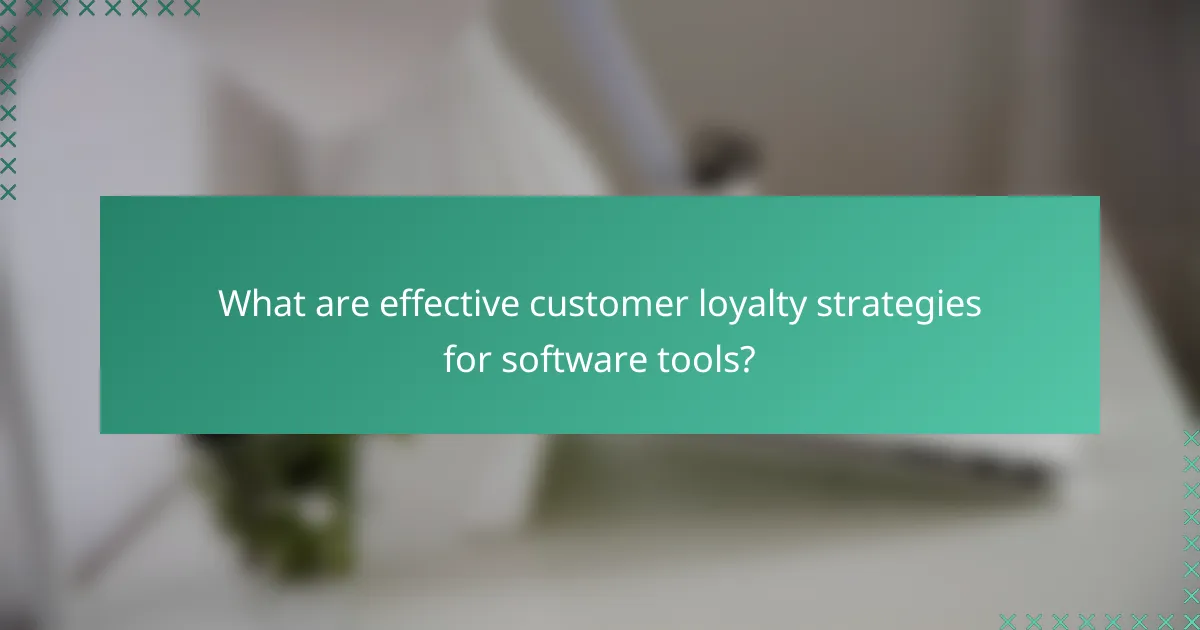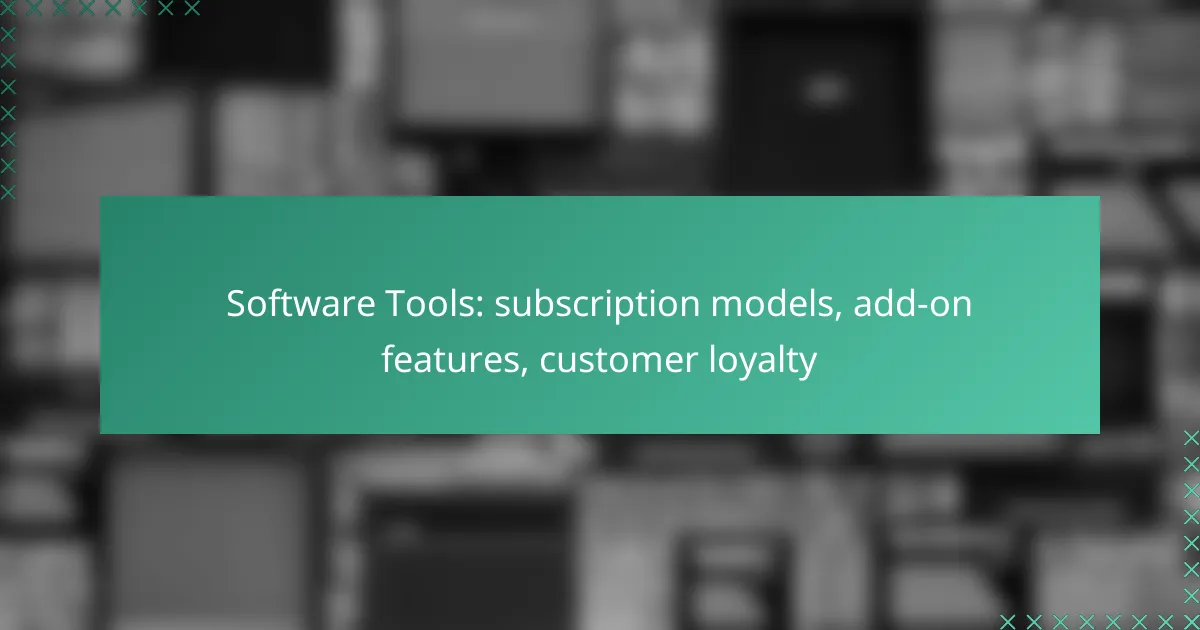In the competitive landscape of software tools, subscription models play a crucial role in aligning user needs with business objectives. Various options, such as monthly subscriptions, freemium models, and tiered pricing, cater to diverse preferences while add-on features enhance functionality and customization. By prioritizing customer loyalty through targeted engagement strategies, companies can build lasting relationships that drive satisfaction and retention.

What are the best subscription models for software tools?
The best subscription models for software tools vary based on user needs and business goals. Key models include monthly and annual subscriptions, freemium options, pay-as-you-go plans, and tiered pricing structures, each offering unique benefits and trade-offs.
Monthly subscription
A monthly subscription model allows users to pay for software tools on a month-to-month basis. This flexibility is appealing for users who want to avoid long-term commitments and can easily cancel if their needs change.
However, monthly subscriptions often come at a higher cost compared to annual plans. Users should consider their usage patterns and budget when deciding if this model suits them.
Annual subscription
Annual subscriptions require users to pay for a full year upfront, typically at a discounted rate compared to monthly payments. This model is beneficial for users who are committed to using the software long-term and want to save money.
While the upfront cost can be a barrier, many software tools offer incentives like additional features or lower rates for annual subscribers. It’s important to evaluate whether the software will be used consistently throughout the year.
Freemium model
The freemium model provides basic features for free while charging for premium features. This approach allows users to try the software without financial commitment, which can lead to higher user acquisition.
However, users may find that essential features are locked behind a paywall, which can be frustrating. Companies should ensure that the free version offers enough value to attract users while encouraging upgrades to paid plans.
Pay-as-you-go
Pay-as-you-go models charge users based on their actual usage of the software, making it a cost-effective option for those with fluctuating needs. This model is particularly useful for businesses that may not require constant access to the software.
While this flexibility can save money, it can also lead to unpredictable costs. Users should monitor their usage closely to avoid unexpected charges and ensure it aligns with their budget.
Tiered pricing
Tiered pricing offers multiple subscription levels with varying features and pricing. This model allows users to select a plan that best fits their needs, from basic to advanced functionalities.
It can cater to different segments of users, from individuals to large enterprises. However, companies must clearly communicate the differences between tiers to help users make informed decisions and avoid confusion.

How do add-on features enhance software tools?
Add-on features significantly enhance software tools by providing users with additional capabilities tailored to their specific needs. These enhancements can improve functionality, allow for customization, facilitate integration, and ultimately lead to a better user experience.
Increased functionality
Add-on features expand the core capabilities of software tools, allowing users to perform more tasks without switching applications. For instance, a project management tool might offer add-ons for time tracking or invoicing, enabling comprehensive project oversight.
When considering increased functionality, evaluate which add-ons align with your workflow. Prioritize features that directly address common pain points to maximize productivity.
Customization options
Customization options through add-on features enable users to tailor software tools to their unique requirements. This can include personalized dashboards, specific reporting formats, or unique workflows that fit individual or team preferences.
To effectively utilize customization, identify the most critical aspects of your workflow that require adjustment. Avoid over-customization, which can complicate usability and lead to confusion among team members.
Integration with other tools
Add-on features often allow for seamless integration with other software tools, creating a cohesive ecosystem. For example, a customer relationship management (CRM) tool might integrate with email marketing platforms, enhancing data flow and communication.
When selecting add-ons, consider their compatibility with existing tools. Look for features that facilitate data sharing and reduce manual entry, as this can save time and minimize errors.
Improved user experience
Add-on features can significantly enhance the overall user experience by making software tools more intuitive and efficient. Features such as enhanced search capabilities or user-friendly interfaces can streamline interactions and reduce learning curves.
To ensure improved user experience, gather feedback from users about their needs and challenges. Regularly assess how well add-ons meet these needs and be open to adjusting or replacing features that do not enhance usability.

What are effective customer loyalty strategies for software tools?
Effective customer loyalty strategies for software tools focus on enhancing user engagement and satisfaction. By implementing targeted programs and features, companies can foster long-term relationships with their customers.
Loyalty rewards programs
Loyalty rewards programs incentivize customers to continue using a software tool by offering benefits for their ongoing engagement. These can include discounts, free upgrades, or exclusive features based on usage milestones or subscription length.
For example, a software company might offer a tiered rewards system where users earn points for each month of subscription, which can be redeemed for additional features or discounts on future renewals. This encourages customers to stay longer and increases their lifetime value.
Referral incentives
Referral incentives motivate existing customers to bring in new users by providing rewards for successful referrals. This can be structured as cash bonuses, account credits, or additional features for both the referrer and the new customer.
A practical approach is to offer a discount on the next billing cycle for each successful referral. This not only attracts new users but also strengthens the bond with current customers, making them feel valued for their contributions.
Exclusive content access
Providing exclusive content access can significantly enhance customer loyalty by making users feel special and valued. This can include premium tutorials, webinars, or early access to new features that are not available to non-subscribers.
For instance, a software tool might offer a monthly webinar series exclusively for loyal customers, helping them maximize their use of the product while reinforcing their commitment to the brand.
Personalized communication
Personalized communication involves tailoring messages and offers to individual users based on their preferences and behaviors. This strategy can significantly improve customer loyalty by making users feel understood and appreciated.
Utilizing data analytics, companies can send personalized emails with tips, feature updates, or special offers that align with a user’s specific usage patterns. This targeted approach can lead to higher engagement rates and a stronger connection with the brand.

What criteria should be considered when selecting a subscription model?
When selecting a subscription model, it’s essential to consider factors such as the target audience’s needs, current market trends, and competitive landscape. These elements will help ensure that the chosen model aligns with customer expectations and business goals.
Target audience needs
Understanding the target audience is crucial for selecting an effective subscription model. Consider their preferences regarding payment frequency, pricing sensitivity, and desired features. For instance, a younger demographic may prefer lower monthly payments, while businesses might favor annual subscriptions for cost savings.
Gather feedback through surveys or focus groups to identify what features and pricing structures resonate most with your audience. Tailoring the subscription model to meet these needs can significantly enhance customer satisfaction and retention.
Market trends
Staying informed about market trends is vital when choosing a subscription model. Look for patterns in consumer behavior, such as a shift towards more flexible payment options or an increase in demand for bundled services. For example, many software companies are now offering tiered pricing models to cater to different user needs.
Monitoring industry reports and competitor offerings can provide insights into what subscription structures are gaining traction. Adapting to these trends can help your business remain competitive and attract new customers.
Competitive analysis
Conducting a competitive analysis allows you to understand how your subscription model compares to others in the market. Identify key competitors and examine their pricing strategies, feature sets, and customer feedback. This information can highlight gaps in your offering and opportunities for differentiation.
Consider creating a comparison table that outlines your subscription features against those of competitors. This visual aid can help clarify your unique selling points and guide adjustments to your model to better meet market demands.

How do software tools compare in pricing?
Software tools vary significantly in pricing based on their subscription models, features, and customer loyalty incentives. Understanding these differences can help users choose the best tool for their needs while managing costs effectively.
Subscription models
Subscription models for software tools typically fall into monthly, annual, or tiered pricing structures. Monthly subscriptions offer flexibility, while annual plans often provide cost savings, sometimes up to 20-30% off the total price. Tiered pricing allows users to select a plan based on their specific feature requirements, which can range from basic functionalities to advanced capabilities.
For example, a project management tool might offer a basic plan at around $10 per month, while premium features could push the cost to $30 or more monthly. Users should assess their needs to determine the most cost-effective subscription model.
Add-on features
Add-on features can enhance the functionality of software tools but may also increase overall costs. Many tools offer essential features in their base subscription, while advanced options, such as integrations or additional storage, are available for an extra fee. This can range from a few dollars to several hundred, depending on the feature.
When considering add-ons, evaluate whether the additional capabilities will significantly benefit your workflow. It’s often more economical to choose a plan that includes necessary features rather than paying for multiple add-ons.
Customer loyalty
Customer loyalty programs can provide significant savings and benefits for long-term users of software tools. Many companies offer discounts for renewing subscriptions, referral bonuses, or exclusive access to new features. These incentives can help reduce costs over time and enhance the overall user experience.
For instance, a software provider might offer a 10% discount for customers who renew their annual subscription early or provide credits for referring new users. Taking advantage of these loyalty programs can lead to substantial savings and improved service.
